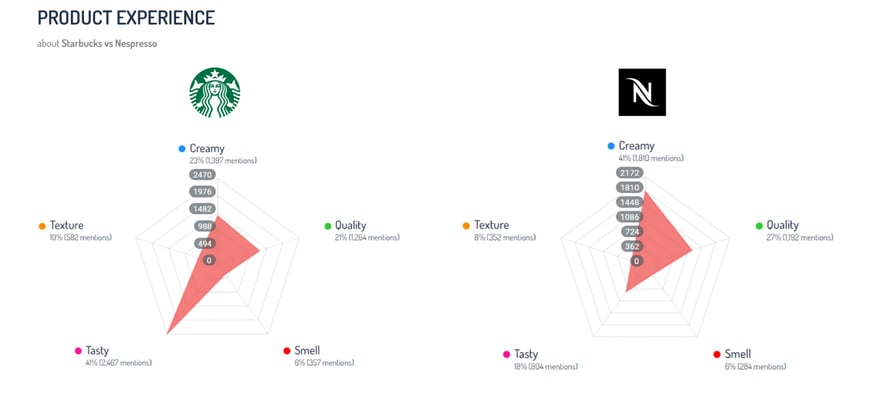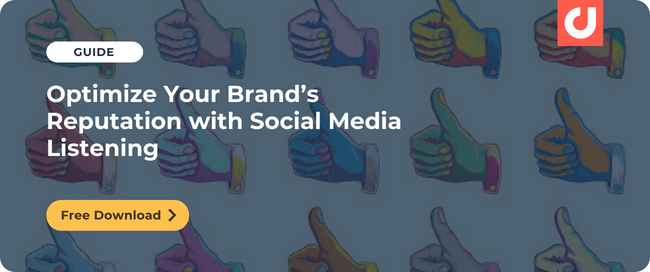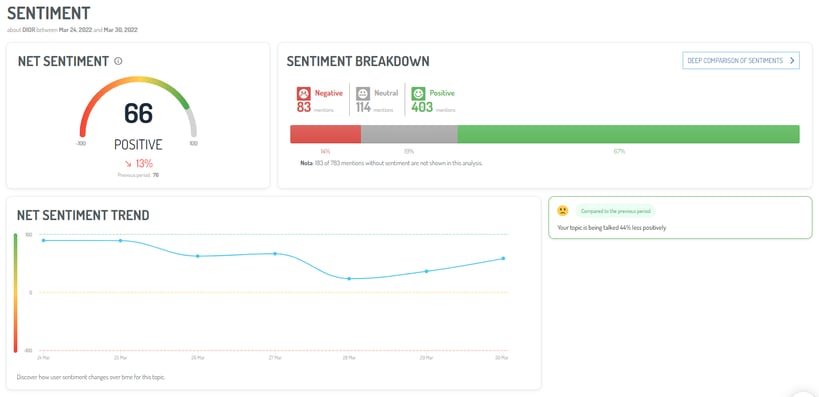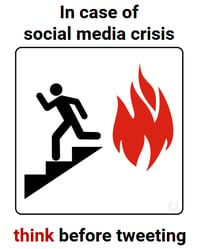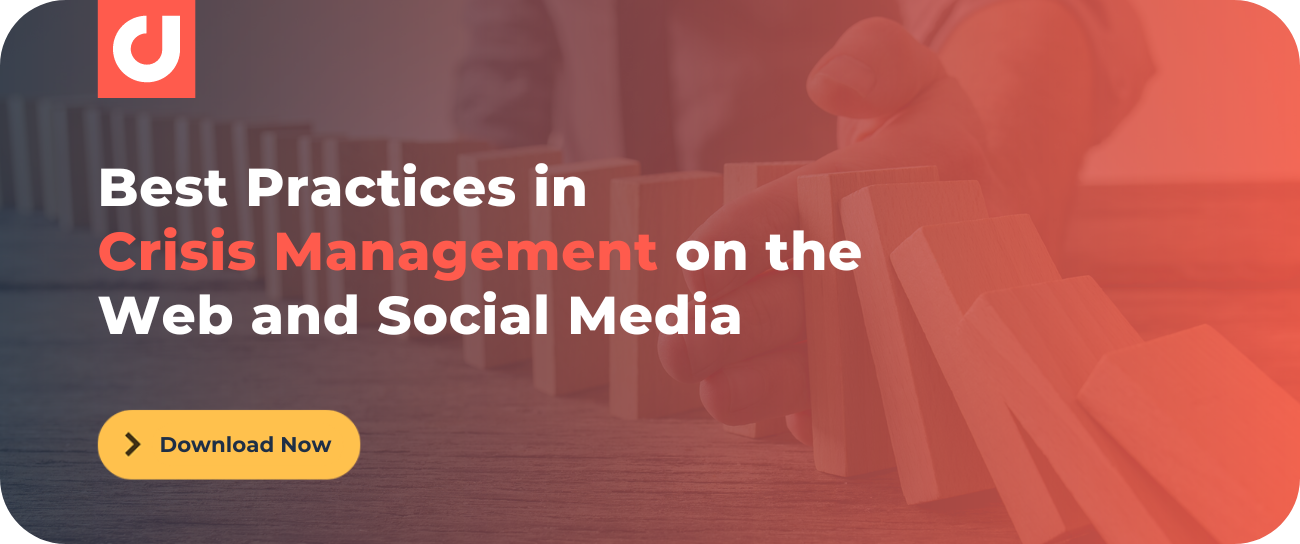3 Steps to Measure the Impact of Reputation Crises on Your Brand
While a company can try to strengthen its brand reputation through communication and content campaigns, brand perception is ultimately shaped by consumers' opinions and experiences.
Imagine you are fighting a fire. How do you stop it? By starving it of oxygen or fuel to prevent it from spreading. The same principle can apply to managing online reputation crises. With social media allowing conversations to spread very quickly, a single incident can result in unmitigated damage to the brand within hours. Negative perception does only affect brand perception but also has a direct or indirect impact on sales. And this for potentially lengthy periods.
While a company can try to strengthen its brand reputation through communication and content campaigns, brand perception is ultimately shaped by consumers' opinions and experiences. Therefore, marketers need to be constantly vigilant about protecting and managing their brand, not only during the crisis but also afterward.
Before deciding on the types of action to take, it is essential to measure the impact of the crisis on your brand's reputation to respond appropriately. It is, therefore, necessary to analyze:
- What is said or sought about your brand during the crisis
- Who talks about your brand
- The perception of your brand during and after the crisis, at three months, six months, one year
It is necessary to collect and analyze consumer opinions and customer insights as quickly as possible.
1. Analyze What Is Being Said or Searched for About Your Brand
The first step in measuring the impact of an online crisis on your brand is to analyze the conversations around your brand.
a. The Volume of Real-Time Discussions and Other Key Indicators
It is essential to monitor the progress of conversations to adapt actions: in short, to avoid overreacting or, on the contrary, under-evaluating the impact of the crisis on social media.
There are 3 points to consider:
- When did the crisis start? Through which transmitters and channels?
- How did it evolve between its starting point and now (pauses, accelerations, reactivations)
- What are the peaks of conversation, and what are the drivers?
To monitor and manage your brand reputation, you need to go beyond the indicators of the volume of mentions of your brands and products. You need to keep an eye on three other important indicators:
Reach: this is the number of unique people reached by all conversations and communications that mention your brands and products. The higher the reach value, the more influential the speakers and channels used are and therefore reach more people with their messages.
Audience: this refers to the number of people potentially exposed to conversations and messages concerning brands. Audience is not to be confused with reach. Where reach only counts for one person, audience emphasizes the total number of exposures.
Interactions: this involves tracking the number of times that messages and content evoking a brand are shared, liked, republished, etc. Strong interactions for a low number of mentions reflect virality, positive or negative interest in the brand.
Of course, it is important to look at the absolute value of these indicators. Still, above all, the evolution of mentions compared to the previous period allows you to understand if your actions (campaigns, communication during a crisis, product launch, etc.) have a real impact on your brand's reputation. Even better: be able to compare these indicators for different brands or different campaigns.
Example: Suppose you want to measure the reputation of Dior on social media.
As a first step, with your social listening tool, you will, at a glance, see your brand's top performance and awareness indicators. You will notice that compared to the previous period, the volume of mentions citing your brand has decreased by 37%, the reach has increased by 38%, and the audience has increased by 56%. Interactions have increased by 26%. Breaking this down, you could infer that key mentions came from influential accounts with a large audience. It indicates a good result because you had run several PR and influencer campaigns over the period.
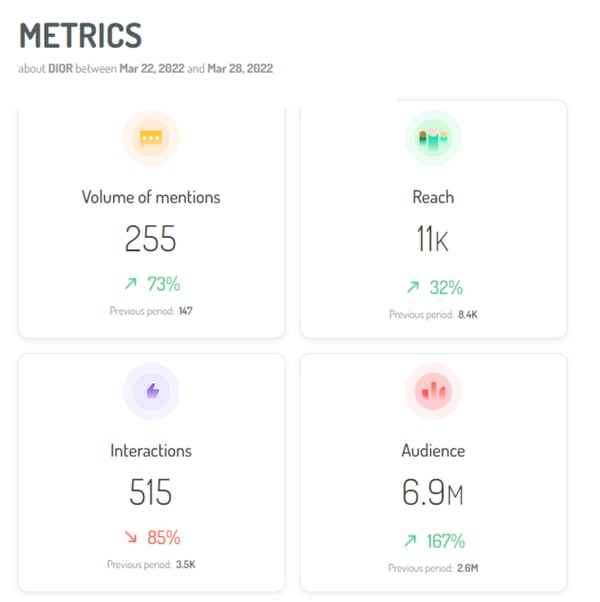
Four key reputation indicators: Reach, Mention Volume, Audience, and Interactions. In value and in progression.
But this analysis is not enough. You need to position yourself against your main competitors and benchmark players on the market. By comparing your indicators with a panel of brands, you can derive insights that inform whether your marketing strategy is working. For example, while your reach over the period is lower than that of your competitor Estée Lauder, its progression is higher in value and progressing positively. You also benefit from more interactions on social media than this competitor. Your audience is in a challenger position, but its growth dynamic is one of the strongest among all your competitors.
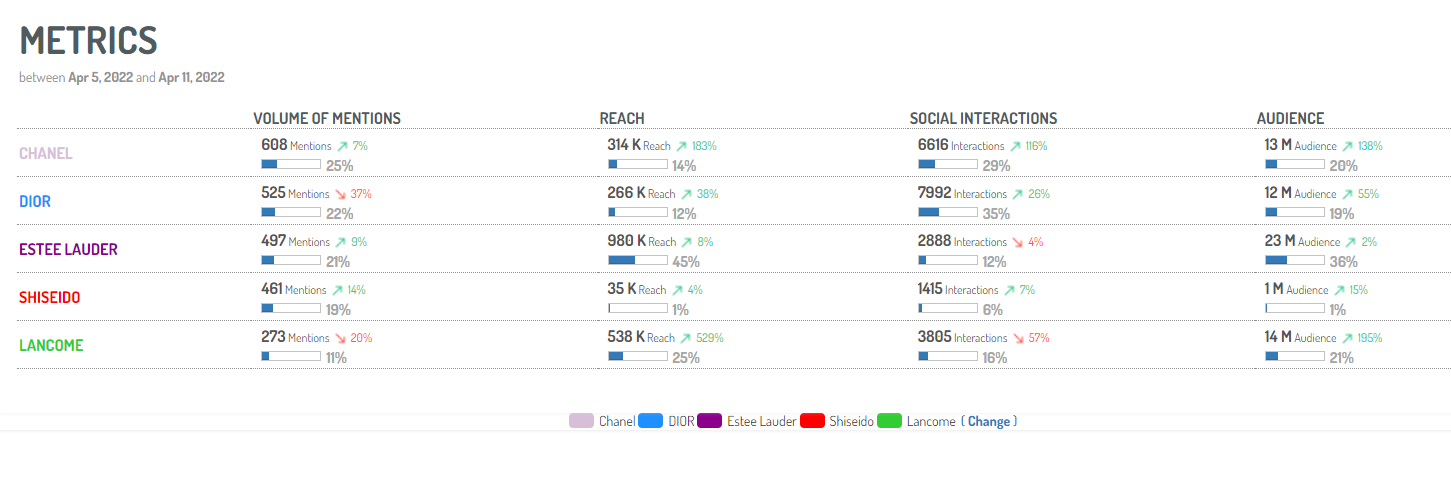 Compare your online reputation KPIs with those of your main competitors.
Compare your online reputation KPIs with those of your main competitors.
The second step is understanding the words and phrases used by your consumers, fans, and detractors and the criteria for your product.
b. The Keywords Used and the Criteria That Matter to Your Consumers
The words and expressions used to talk about the crisis, and your brands are clues to how consumers perceive the crisis and its aftermath.
Use a social media monitoring and analysis tool to collect mentions around the brand to:
- Identify critical issues: what are the common concerns raised by consumers? Is your brand systematically linked to the crisis?
- Analyze related hashtags: it is not uncommon for customers and consumers to group their opinions or complaints under a common hashtag (e.g., #boycottUnited).
It is important to monitor the evolution of these hashtags over time to get more information beyond mentions of your brand on your owned social media accounts and pages. Indeed, 85% of consumers do not always tag the brand account or handle (e.g., @united) to share their experiences. Also, complete listening is not only about owned media but also about all social media, forums, and blogs where consumers can express themselves.
Case Study:
When the Volkswagen scandal ensued in September 2015, a huge spike in tweets occurred following a news report (more than 700,000 in Europe in five days), all relaying the manufacturer's cheating.
Did all the mentions talk about the crisis? Not exactly. Some posts were not related to the scandal. By analyzing 150,000 tweets in French mentioning the Volkswagen group between 21 and 24 September, we can see that almost 30% did not correlate to the cheating scandal.
Moreover, it would be best if you do not stop at social media alone. The impact of a crisis can also be measured via the search terms associated with your brand in search engines. In France, Internet users use Google significantly (more than 90% of the market share). The more important a crisis is, the more quickly and repeatedly the related search terms will appear in the keywords related to your brand in Google suggestions. Understanding the keywords searched for around your brand can help optimize crisis communications by factoring in these terms. That way, when consumers search for these terms, they will also potentially see the content the company created in response to the crisis.
Beyond the keywords used, it is essential to understand which dimensions of your brand, products, and services are most important to your consumers and which will constitute part of the "drivers" of your brand reputation.
Comparing product experiences on social - Nespresso vs Starbucks example
Take, for example, your brand's moisturizer. When consumers quote your brand, they are primarily talking about its fragrance, the innovation of the product, and to a lesser extent, its composition. An analysis via a radar graph allows you to see these criteria at a glance.
A comparison with a competitor shows that consumers also describe their products as innovative but secondarily on price, a criterion absent from the discussions for your customers.
c. Analysis of Feelings
Before you are overwhelmed by the volume of brand-related messages when a crisis occurs, especially for B2C companies, take a step back. Do most messages evoke anger at your brand, or are people just curious, asking questions, or neutrally sharing and discussing?
Case Study:
When an antivirus software identified a computer program pre-installed by a PC manufacturer as malware, a major supplier of affected computer components of that PC brand wanted to know if there was a reputational risk to its own brand. After listening to and analyzing 57,000 conversations and messages on social media, the supplier concluded that customers had not associated the PC manufacturer and the component supplier with the crisis. As a result, the supplier never officially communicated about this.
With advanced sentiment analysis, your social listening tool will allow you to know exactly how consumers feel about your brand when they express themselves on social media.
- Net sentiment: the net sentiment figure expresses the difference between the volume of negative and positive mentions.
- Analyzing the evolution allows you to understand how the share of positive vs. negative feelings evolves over your study period study period
Net sentiment to properly assess the evolution of feelings toward your brand.
Through this, you would have an overview of the evolution of sentiment based on your communication and PR campaigns and your corrective actions in the event of crises and bad buzz.
You can see at a glance whether your brand is being talked about more positively or negatively, compared to the previous period, and in what proportion.
These indicators complement the distribution of sentiments by the number of mentions you can compare to the main competitors in your sector.
Sentiment Benchmark on Competitor brands.
2. Who Is Talking About Your Brand During the Crisis?
While everyone can talk about your brand, not everyone has the same reach and influence. The greater the influence of transmitters, the more significant the impact of an online crisis on your brand's perception, with more people aware and engaged in the discussion.
Measure this impact by asking yourself the following questions:
- If a customer, a blogger/YouTuber, or an activist has posted a complaint on social media, has the message gone viral, or has the news been picked up by mainstream media? By specialized media? By media outlets or sites widely read by journalists?
- Are customers mobilizing around your brand or adding to the discussion by sharing their own negative experiences or boycotting your products and services?
- Did the buzz attract other individuals or groups outside the original detractor's personal network?
3. What Is the Perception of Your Brand During and After the Crisis?
Just like you assess the damage caused after a fire is extinguished, it is similarly crucial to monitor the impact of the crisis on brand perception, not only when it happens but also post-crisis, based on periodic reviews.
Only then can you determine:
- If your brand has fully "recovered" from the crisis, and if customers have forgiven and forgotten
- If it is appropriate to launch a new content or branding campaign, or if your PR team needs to deal with the crisis again
Assess the "consequences" by analyzing:
- The time it takes for crisis-related discussions to plateau or diminishes
- If the elements of the crisis are still the leading search keywords related to your brand
 One year after the Volkswagen crisis began, Internet users' concerns about the brand on Google had returned to "normal."
One year after the Volkswagen crisis began, Internet users' concerns about the brand on Google had returned to "normal."
What Next?
Rebuilding your brand's reputation after a crisis requires tact and good timing. Social media monitoring is essential for:
- Tracking the sites and influencers who have championed your brand and who you can work with for your post-crisis campaign
- Identifying key complaints that should be addressed individually and in official communications
- Determining whether your brand communications should continue as normal or take the next steps to respond based on the volume of crisis-related discussions, the nature of the keywords in the conversations, and the feelings towards your brand
4. Preparing Yourself BEFORE the Crisis
The success of crisis management and the performance of your crisis watch will largely depend on the preparation beforehand, on the web, in social media, and in real life. To find the best practices for anticipating crises, download this ebook today.
Written by Jared Silitonga
Jared is a member of the APAC marketing team at Digimind. Besides hashing insights into content, he loves a good ol' sit-down of board gaming and film rhetoric. Catch him diving in other shenanigans on Instagram @jarrds

